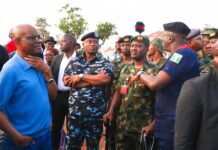NIGERIA’S NEW WORLD TRADE CENTRE POISED TO SEND ITS ECONOMY SKY-HIGH
Nigeria’s capital city of Abuja is about to get a new heart: a brand new World Trade Centre complex. The centre is expected to open to the public early next year after the completion of the first phase of construction. It will join a network of 323 locations in 89 countries, started in 1970 with the inauguration of the first World Trade Centre in New York City. Funded by local and foreign financial institutions, as well as private investors, to the tune of 200billion Naira, or just over $1billion, the WTC Abuja will be the largest mixed-use development in West Africa. WTC Abuja has been under development since 2010, on a plot spanning over six million square feet in the Central Business Area of the capital. The location offers easy access to the city centre and the airport, with a dual-carriage highway surrounding the site and a new light rail system currently under construction. For business tenants, though, the most important connections will be those with the global network of 750,000 entrepreneurs that make up the World Trade Centre’s Association (WTCA). “One of the missions of WTC Abuja is to improve trade relations between Nigeria and the rest of the world,” Vinay Mahtani, CEO of the site’s developer, Lagos-based Churchgate Group, told CNN. Ties will be forged between government agencies, non-governmental organizations and international corporations, and the additional business that is captured within the walls of the World Trade Centre will provide tax revenues to government which can be used to improve the welfare of the people (CNN.com).
PRINCESS CHARLOTTE: WORTH $5 BILLION AFTER FOUR MONTHS
The youngest member of the royal family, few months old Princess Charlotte, will be worth nearly $5 billion to the British economy, according to Brand Finance. Her brother? A mere $3.6 billion. True, the princess is still trailing her mother Catherine, the Duchess of Cambridge, whose contribution is estimated at $7.2 billion. But given Charlotte has only appeared in public twice, the day she was born, and during her christening, the value she’s already generating for British business is impressive. The “Charlotte effect” brought a huge uplift to fashion and other brands the little princess has worn or been associated with. Her birth generated economic benefits of more than $150 million, Brand Finance estimates. “The unofficial endorsement of Charlotte, George and Kate in particular has a profound financial effect running into millions annually,” said CEO David Haigh. The $100 lacy shawl she wore when her parents introduced her to the world has been selling fast ever since, according to the makers. “The shawl is still very popular, we have seen a big increase in orders from all around the world in the last couple of months, thanks to all the media coverage,” said Gillian Taylor, director at G.H. Hurt & Sons. And the vintage pram that carried Charlotte to her christening caused a similar craze. Prams with Pizazz, a company that restores vintage strollers, was “inundated with messages, emails and calls” after the ceremony, its owner Scott Frew said. “The Firm,” as Queen Elizabeth II reportedly calls the royal family, is worth $87 billion in total, adding $1.8 billion to the British economy every year, according to Brand Finance (CNN.com).
NEW HUMAN-LIKE SPECIES DISCOVERED IN SOUTH AFRICA
Scientists have discovered a new human-like species in a burial chamber deep in a cave system in South Africa. The discovery of 15 partial skeletons is the largest single discovery of its type in Africa. The researchers claim that the discovery will change ideas about our human ancestors. The studies which have been published in the journal Elife also indicate that these individuals were capable of ritual behaviour. The species, which has been named Naledi, has been classified in the grouping, or genus, Homo, to which modern humans belong. The researchers who made the find have not been able to find out how long ago these creatures lived; but the scientist who led the team, Prof Lee Berger, told BBC News that he believed they could be among the first of our kind (genus Homo) and could have lived in Africa up to three million years ago. Like all those working in the field, he is at pains to avoid the term “missing link”. Prof Berger says Naledi could be thought of as a “bridge” between more primitive bipedal primates and humans. “We’d gone in with the idea of recovering one fossil. That turned into multiple fossils. That turned into the discovery of multiple skeletons and multiple individuals. “And so by the end of that remarkable 21-day experience, we had discovered the largest assemblage of fossil human relatives ever discovered in the history of the continent of Africa. That was an extraordinary experience.” Prof Chris Stringer of the Natural History Museum said Naledi was “a very important discovery”. The haul of 15 partial skeletons includes both males and females of varying ages – from infants to elderly. The discovery is unprecedented in Africa and will shed more light on how the first humans evolved. “We are going to know everything about this species,” Prof Berger said. “We are going to know when its children were weaned, when they were born, how they developed, the speed at which they developed, the difference between males and females at every developmental stage from infancy, to childhood to teens to how they aged and how they died.” (BBC.com).
KENYAN MEN ARRESTED WITH ‘MALL IED’ IN NAIROBI
Three men have been arrested at a shopping centre in Kenya’s capital with a suspected explosive device, which has since been detonated in a controlled explosion, police say. The Garden City Mall, one of the biggest shopping centres in the city, has also been evacuated. One of the men refused to be searched by security guards and was overpowered in a scuffle, a witness said. In 2013, al-Shabab gunmen killed 67 shoppers at the city’s Westgate mall. Police spokesman George Kinoti told the BBC that the three men in custody were all Kenyans and the explosives were discovered in one of their bags. “The situation is under the absolute control of our security agencies and the entire country is under multi-agency surveillance,” he said. The BBC’s Alastair Leithead in Nairobi says it is believed to have been a small explosive device with a battery and a mobile phone attached, which could have been used as a trigger. A statement from Garden City Mall quoted the governor of Nairobi Evans Kidero as saying it would reopen soon. Mr Kidero also thanked the local police and mall employees for their “swift handling and containment of the situation.” Following the Westgate siege, security was stepped up at Nairobi’s shopping complexes. Al-Shabab has since launched a number of high-profile attacks, including one in April on a university in the north-eastern town of Garissa in which close to 150 people died. (BBC.com/new/world/Africa)
JAPAN FLOODS: CITY OF JOSO HIT BY ‘UNPRECEDENTED’ RAIN
Widespread flooding and landslides in north-east Japan have forced more than 90,000 people to abandon their homes. The city of Joso, north of the capital, Tokyo, was hit by a wall of water after the Kinugawa River burst its banks. Helicopter rescue teams have been plucking people from rooftops. At least eight people are still missing and 100 need rescuing. The rains come a day after a tropical storm brought winds of up to 125km/h (78mph) to central Aichi prefecture. The chief forecaster at the Japan Meteorological Agency (JMA), Takuya Deshimaru, said that the rainfall was “unprecedented” for that part of Japan. “We can say this is an abnormal situation and there is imminent serious danger,” he went on. Japan gets hit by, on average, 20 to 30 such storms each year. This is the 18th this year so despite the heavy rainfall that we have experienced over the last few days, it was difficult to predict how severe the damage would be. The Kinugawa River bursting its banks took even experts by surprise, especially because of the widespread areas that it has affected. Just as in previous natural disasters, including the 2011 earthquake and tsunami, Japan’s non-combat military Self-Defence Force is playing a major role in the rescue operations and it is receiving lots of praise so far. But there are concerns that these storms are getting stronger in recent years and more preparations may be needed in the future. (BBC.com)
BURUNDI ARMY CHIEF ESCAPES ASSASSINATION ATTEMPT’
The head of Burundi’s armed forces has survived an assassination attempt in the capital Bujumbura, police said, adding that at least seven other people were killed in the attack. “There was an attack against the armed forces chief, General Prime Niyongabo, but happily he was unharmed,” Burundi’s deputy police chief, General Godefroid Bizimana, told AFP news agency. He said two attackers were killed in the clash, and a third arrested. Another senior police source said four bodyguards were also killed, as well as a female police officer. Another senior police source, who asked not to be named, said the attack appeared to have been “meticulously prepared”. Tensions remain high in the central African nation following President Pierre Nkurunziza’s successful bid for a third term in power in July. Nkurunziza won a highly-controversial third term in July in polls the United Nations said were not free or fair. His bid sparked an attempted coup and months of civil unrest led by opposition groups, who condemned his re-election bid as unconstitutional. There has also been a string of killings since his re-election, including the assassination of his top security chief in a rocket attack last month. Many have raised alarm bells at the risk of renewed conflict in Burundi, which lies in the heart of central Africa’s troubled Great Lakes region. At least 300,000 people were killed in a civil war there which ran from 1993-2006. (Aljazeera.com/news)













